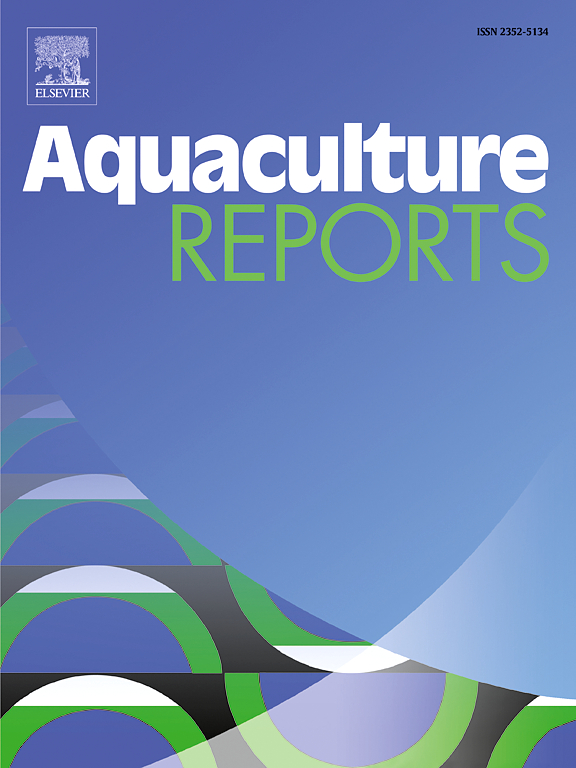凡纳滨对虾(Litopenaeus vanamei)耐缺氧qtl鉴定及候选基因筛选
IF 3.2
2区 农林科学
Q1 FISHERIES
引用次数: 0
摘要
凡纳滨对虾(Litopenaeus vannamei,又称凡纳滨对虾)在全球水产养殖中占有举足轻重的地位,其生长和存活受到养殖缺氧条件的显著影响。本研究旨在揭示低氧耐受性的遗传基础,以提高农业效率和可持续性。我们评估了一个对虾定位家族的耐缺氧性,并确定了与该性状相关的数量性状位点(qtl)和候选基因。F1全兄弟姐妹家族在缺氧耐受性方面表现出显著差异,在溶解氧水平为0.4 mg/L时,平均存活时间为13 小时。对200个后代及其父母进行全基因组测序,得到81892个标记,形成了5386.79 cM以上44个连锁群的遗传图谱。连锁群长度为12.79 ~ 196.86 cM,平均为122.43 cM,标记距离为0.03 ~ 0.61 cM,标记密度在LG11和LG44中分别最高和最低。QTL分析发现8个与低氧耐受性相关的QTL,包含78个注释基因,其中13个被鉴定为低氧耐受性的候选基因。低氧耐受性和低氧不耐受性个体的RNA-seq分析揭示了1973个差异表达基因,GO和KEGG富集分析强调了它们在DNA修复、RNA加工和氧化还原相关途径中的作用。整合QTL和RNA-seq数据,确定了11个在缺氧胁迫下差异表达的基因。本研究不仅促进了对凡纳梅耐缺氧遗传机制的认识,而且为通过基因改良增强耐缺氧能力奠定了基础。本文章由计算机程序翻译,如有差异,请以英文原文为准。
Identification of QTLs and candidate genes screening for hypoxia tolerance in Pacific white shrimp (Litopenaeus vannamei)
The Pacific white shrimp (Litopenaeus vannamei, also known as Peneaus vannamei) is pivotal in global aquaculture, with its growth and survival significantly influenced by hypoxia conditions in farming. This study aimed to uncover the genetic basis of hypoxia tolerance to enhance farming efficiency and sustainability. We evaluated hypoxia tolerance in a shrimp mapping family and identified quantitative trait loci (QTLs) and candidate genes associated with this trait. The F1 full-sibling family exhibited significant variation in hypoxia tolerance, with an average survival time of 13 hours at dissolved oxygen levels of 0.4 mg/L. Whole-genome sequencing of 200 offspring and their parents generated 81,892 markers for a genetic map with 44 linkage groups over 5386.79 cM. The linkage group lengths ranged from 12.79 cM to 196.86 cM, averaging 122.43 cM, with marker distances from 0.03 to 0.61 cM and highest and lowest marker densities observed in LG11 and LG44, respectively. QTL analysis revealed 8 QTLs associated with hypoxia tolerance, encompassing 78 annotated genes, 13 of which were identified as candidate genes for hypoxia tolerance. RNA-seq analysis of hypoxia-tolerant and hypoxia-intolerant individuals revealed 1973 differentially expressed genes, with GO and KEGG enrichment analyses highlighting their roles in DNA repair, RNA processing, and redox-related pathways. Integrating QTL and RNA-seq data pinpointed 11 genes with differential expression under hypoxic stress. This study not only advances the understanding of the genetic mechanisms underlying hypoxia tolerance in L. vannamei but also establishes a foundation for enhancing hypoxia resilience through genetic improvement.
求助全文
通过发布文献求助,成功后即可免费获取论文全文。
去求助
来源期刊

Aquaculture Reports
Agricultural and Biological Sciences-Animal Science and Zoology
CiteScore
5.90
自引率
8.10%
发文量
469
审稿时长
77 days
期刊介绍:
Aquaculture Reports will publish original research papers and reviews documenting outstanding science with a regional context and focus, answering the need for high quality information on novel species, systems and regions in emerging areas of aquaculture research and development, such as integrated multi-trophic aquaculture, urban aquaculture, ornamental, unfed aquaculture, offshore aquaculture and others. Papers having industry research as priority and encompassing product development research or current industry practice are encouraged.
 求助内容:
求助内容: 应助结果提醒方式:
应助结果提醒方式:


